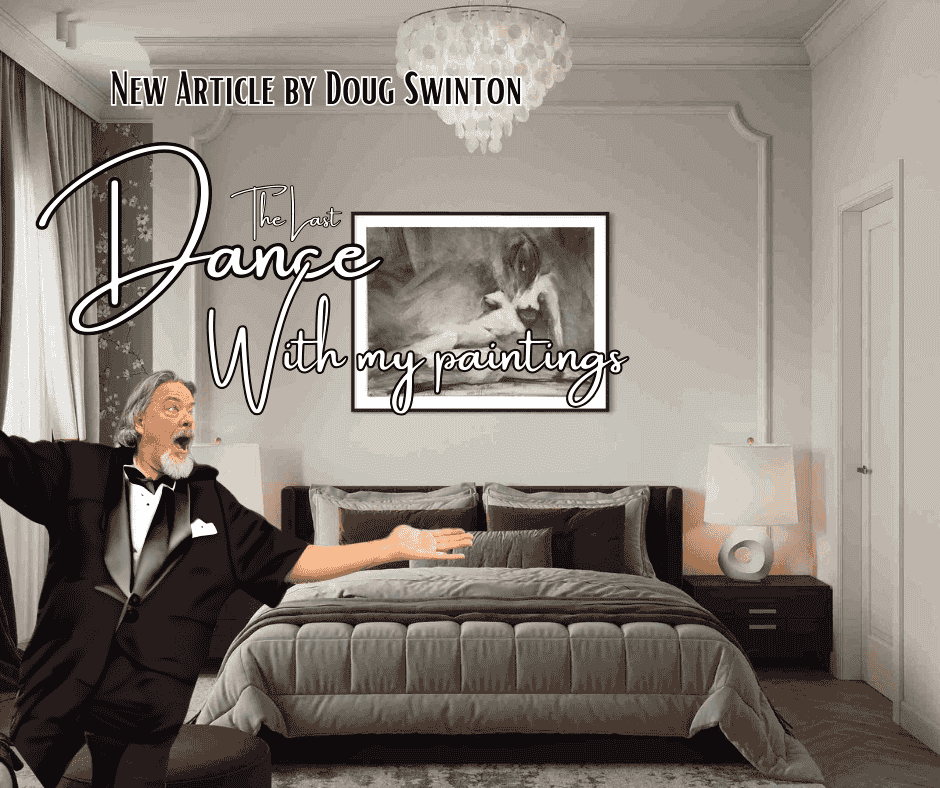10 Things About Painting Skies
- Doug Swinton

- Mar 10, 2020
- 5 min read
Updated: Mar 15, 2021
by Doug Swinton

The most common problem in landscape painting has to do with the sky. For example, when a painting seems dark, dreary or drab, the problem is usually in the sky. In the hundreds of critiques I have done over the years, one common factor repeats itself - The value of the sky is too dark, generally causing the rest of your the values to drop down, causing an overall sombre feeling to the work...
This article is about a few important things to keep in mind in order to get better results.
1. Value Before Colour
In most painting compositions the sky should be the lightest value. In the hundreds of critiques I have done over the years, one common factor repeats itself - The value of the sky is too dark, generally causing the rest of your the values to drop down, causing an overall sombre feeling to the work. This is even more of a common occurrence in outdoor painting. Tune your values to the sky and you will get a better read on the painting. Be careful especially on overcast days, when the sky may seem dark and dreary . There is a lot more light radiating than you think.
When I am painting on a white canvas, I will usually leave the canvas bare in the sky area until well into the painting process. I like to key the flat land or “ground planes” based on the value of this blank white canvas or sky area. This area is already close to the right value and I work with it as long as I can.
Conversely, if I have a toned canvas I will put some kind of light value into the sky fairly early on so that I can key the flat ground plane to this sky value in order to get the correct land value.
2. Top to Bottom
Gradation in value and temperature from top to bottom makes your sky read more accurately.
The horizon of the sky tends to be bluer, greener and cooler than the zenith of the sky. This is how it works… On a clear Alberta day, when you look at the horizon (where sky meets earth), it is approximately 125 kms away. Looking straight up, from the ground to where the sky turns to space, we can only see about 50 kms. The farther away things are, the bluer and cooler the colour gets. Because the distance to the zenith is half the distance of the horizon, colour is much warmer and darker. The horizon has a blue-green sometimes lemon yellow cast to it, while the top of the sky will be much warmer having more of a red bias to it.
Safe bet: Manganese blue at the bottom and Ultramarine near the top.
3. Side to Side
The sky gradation is not only from top to bottom but also side to side. Colours that are closer to the light source will be warmer. Colours away from the sun will be cooler in temperature and take on an almost violet colour.
Lighter and warmer towards the direction of the sun (sunlight).
Cooler and darker away from the direction of the sun (skylight).
4. Go Big or Go Home
Skies are often the most abstract part of a landscape, so you can really have a lot of fun conveying all the energy and drama that the atmosphere can provide. With a big brush (and I mean big), strokes can be applied with freedom. This is the part of the painting where you can truly showcase your brushwork and put some personality into the painting.
Use your largest brushes and be as loose as you can, but try to make every brushstroke count. You don’t need to show things exactly as they are, you can adjust elements to improve the composition and create more or less drama. What matters is that you have the right value and convey the right mood in a bold way.
5. Thick over Thin
One way to achieve the feeling of atmospheric light travelling towards you is to use thicker paint. Thin paint recedes and thick paint come forward. Be aware that thick paint tends to read darker in value than it is. The way to compensate for this is to paint on a thin layer in the correct value first, then apply a second thicker layer. From time to time I will use a slightly warmer tone in the first thinner layer then come back over it with a thicker cooler colour letting some of the warm colour underneath show through.
6. Blue Bayou
For most sky paintings I will paint all the clouds (shadows, mid-tone and highlights) first then negative paint the blue of the sky around the clouds. This gives the clouds a fluffier feel.
7. No Whites After Labor Day
Remember that the farther away whites are from the viewer, the warmer they appear. So keep the whites in your clouds a little warmer than you think.
8. Rainbow Road
Referring back to what was mentioned in #2 and #3 there can be many colours in the sky other than blue. Try a combination of purples, violets or greens to add some variety into your sky. Just remember to keep your values close when you’re adding other colours so they don’t “pop” and alienate themselves.
9. The Grey Way
As much as everyone loves the bright colours of sunrises and sunsets, a painting crammed with a myriad of intense colours gets a little tiresome on the eyes. Neutral, greyed down colours allow for resting areas and help enhance the more intense areas.
Some dull and “ugly” colours are necessary to make the vibrant colours sing. Greys are a great complement to a colourful sky. A bright orange will look even brighter if placed next to a purply grey.
NOTE: When I say grey, I don’t mean a mixture of black and white or grey from a tube. To keep the greys chromatic while ensuring colour harmony, create them with triads of complementary colours. You should always be using some sort of combination of red, yellow and blue.
10. Building Blocks
I usually build up a painting with layers from dark to light, ending up with the thickest application of paint for the highlights. To achieve vibrant sunsets, or sunrises, prime your canvas with a bright orange or yellow and then add the clouds, greys and blues in the skies, making sure you let some of the ground colour show through, especially in the most vibrant parts of the sunset. Finish with some touches of bright yellow mixed with white to enhance the focal points.
Tip: Morning skies are generally cool in nature and sunsets are warmer.
11. Bonus!
To make the snow on mountains look brighter, darken the value of your sky a little to make the whites look brilliant. Caution though, if you darken the sky too much you can loose the glow in your mountains reflected light.
Here are 10 fun paintings of skies that are not painted blue...

This Camille Przwewodek piece has a lovely soft feel and the pink sky brings it all together.

The yellow sky Mark Hanson plays up adds to the feel of the heavy winter air.

Bill Duma plays up a yellow sky to bring harmony to the landscape and the feel of the cool evening air.

Lori Putnam is choosing a complimentary colour scheme and finishes the painting off nicely with a red sky. Okay its pink, but pink is just red with white in it….. A red sky I tell you, now that’s a slam dunk.

Painting the sky the same value and colour as the back water takes skill. Maybe its more guts than skill, or maybe a bit of both, but whatever it is it works. Kudos to Robert Genn.

Carol Zoilla Captures the misty feel with the use of the lavender theme in this small piece.

Scott Christensen laying it on thick. Nice use of texture.

Mike Svob knows only too well how to place a two toned green and yellow sky to play off the red boats.

UK artist Peter Wileman with a purple sky.

From the land down under, Cholley Whissan lusciously paints a dark sky here to play off the warm land make it pop brighter and it works beautifully.
Let me know if you have any questions or leave a comment below.
Your friend in art,
Doug.








monero miners monero miners
monero miners monero miners
monero miners monero miners
monero miners monero miners
monero miners monero miners
monero miners monero miners
etc mining etc mining
monero miners monero miners
monero miners monero miners
monero miners monero miners
monero miners monero miners
monero miners monero miners
monero miners monero miners
etc mining etc mining
monero miners monero miners
monero miners monero miners
monero miners monero miners
monero miners monero miners
monero miners monero miners
monero miners monero miners
etc mining etc mining
monero miners monero miners
monero miners monero miners
monero miners monero miners
monero miners monero miners
monero miners monero miners
monero miners monero miners
etc mining etc mining
monero miners monero miners
monero miners monero miners
monero miners monero miners
monero miners monero miners
monero miners monero miners
monero miners monero miners
etc mining etc mining